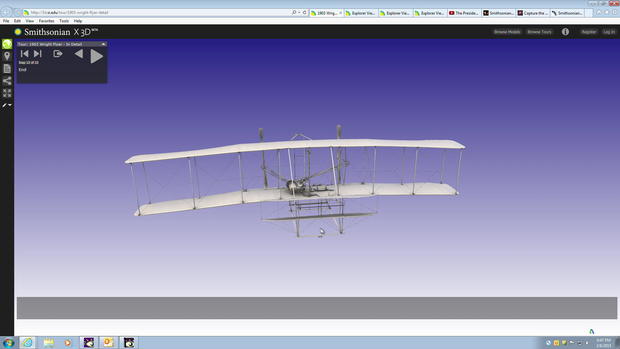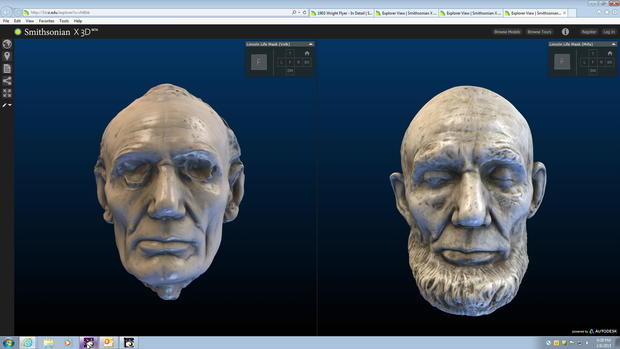3-D imaging takes Smithsonian into your home
The Smithsonian is going 3-D for virtually all of its 169-year history.
It used to be if you wanted to see some of the 138 million items in the Smithsonian collection, you had to go to Washington, D.C. But not anymore as it's launched an ambitious new project, CBS News' Mark Albert reports.
In the bright atrium of the National Air and Space Museum in Washington, two men are using light to stop time.
Adam Metallo, a former painter, and Vince Rossi, a former sculptor, have carved out a niche as the Smithsonian Institution's laser cowboys. They're scanning cherished pieces of American history, like the Spirit of St. Louis, in 3-D, before it's too late.
Charles Lindbergh flew the single-propeller plane across the Atlantic Ocean in 1927, the first person to make the trip non-stop alone.
While his record will hold up, the aircraft's original fabric skin will not. So the Smithsonian has lowered the plane for the first time in a generation to capture it for all-time.
A single 20-minute, 180-degree scan records 5-10 million measurements. The museum will then fuse those with traditional photography.
Metallo and Rossi are blending the 3-D image along with color, 2-D photographs.
"That's what allows us to create an incredibly life-like digital version of this object," Metallo said.
"We're going to use this data to bring this airplane to the world," said Gunter Waibel, "get up close and personal with this airplane in a way they've never been able to do before."
Waibel leads the Smithsonian's digitization program. It has a lofty goal of scanning 16 million of the institution's artifacts, objects and specimens. That's just 11 percent of the entire Smithsonian collection, only 2 percent of which is on physical display.
The Smithsonian has already created a 3-D image of the 1903 Wright flyer -- the world's first powered airplane -- now taking off in a new medium. The newly scanned 3-D objects, like this original Revolutionary War gunboat, can be brought back to life with a 3-D printer.
"You can print your own Smithsonian collection item at home, have it sitting on your coffee table, share it with your friends, discuss what it means to you," Waibel said. "This is a 3-D print of a Lincoln life mask from 1865 where you see a very, very aged Lincoln with deep furrows on his face. And I think the experience of being able to hold that and actually touch these furrows on his face, I'm sitting here, it sends chills down my spine."
An aged Lincoln can be compared to his younger self, before the Civil War.
And from the 16th president to the 44th.
The laser cowboys recently scanned Barack Obama at the White House.
But what is the project's goal?
"I think to provide people with the raw material to tell their own stories and also to feed scientists the data they need in order to make new discoveries and address vital questions, such as why are bee colonies collapsing in the United States," Waibel said.
Meghan Ferriter is leading the effort to transcribe the scanned items into a searchable, online database, 4,500 volunteers worldwide, discovering and documenting history long since forgotten.
It feels like going through the Smithsonian's basement in a way.
"We're getting a chance to go through all the lockboxes of treasure down there," Ferriter said.
The bee specimens, and items never before seen publicly, like proof sheets of century-old currency, speed through the first scanning assembly line of its kind at a U.S. museum.
"So we used to be able to do a few dozen of these sheets a day. Now, we can do three to four thousand a day," Waibel said.
The resolution is sharp, and the insights are clear. If history is a collection of treasures or moments, the Smithsonian hopes the light of a 3-D scanner can do what our memories cannot: Preserve the past long into the future.
"I think James Smithson would absolutely have loved it," Waibel said of the man for whom the Smithsonian is named. "He understood that when information gets shared, science gets better."

